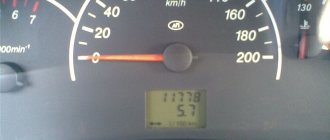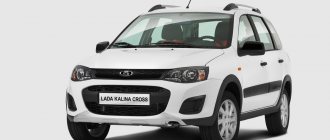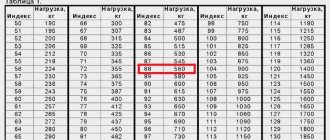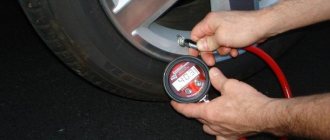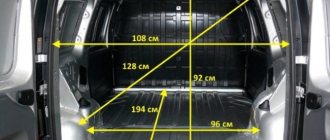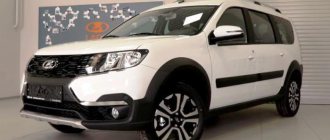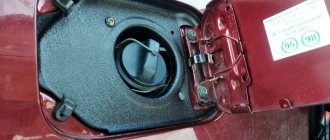In the middle of summer 2014, VAZ presented the Lada Kalina Cross station wagon and immediately after that they reported a lot of information about another car of the same class - the Lada Largus Cross. Already at the end of the same 2014, the debut of the station wagon took place at the MIAS-2014 exhibition. Generally speaking, the Lada Largus Cross is a small class vehicle, which is a 2006 Dacia Logan MCV 1 family car, produced in Romania, adapted for the domestic market.
This station wagon almost immediately began to be in great demand, which, coupled with all the advantages of the car and its cost, was quite expected. Given the serious market decline in 2014, dealers sold more than 65,000 vehicles, which was 7,500 more vehicles than last year. The entire Lada model range.
Exterior
Largus Cross is not very different from the usual Largus, except in some details. Such details were those elements that required modernization. The developers wanted the car to move freely off-road and not be afraid that the appearance would become shabby.
When purchasing a car, it is important for the buyer not only what is under the hood, but often even the opposite, the priority is comfort and good appearance. In this regard, the basic version was not bad, and the updated “Cross” modification only improved in this regard. And during the presentation, no one said that any special degeneration would happen; the main goal was to improve the cross-country ability and the corresponding qualities of the station wagon.
When examining the Lada Largus Cross, you notice differences from the basic version, but first of all this is expressed in increased ground clearance and is complemented by small details. Thanks to this decision, the model finally acquired a more harmonious and complete look. The front bumper gets a black body kit with fog lights, which definitely adds an off-road look to the car.
In general, everything remains the same. Front lamps convey calm and confidence. Between them there is a false radiator grille with a chrome strip and the company logo. And the air intake from below even creates the illusion that the car’s face is smiling at you.
The hood is minimalist with barely visible fins running lengthwise to the windshield mirror. From the side everything is just as laconic. The side “skirt” is also made of black plastic. There is a strip to protect the doors from impacts. The door windows are located high. And large rear-view mirrors are mounted on the front doors.
It is worth adding that the wheel fenders are made of the same black plastic. The back side of Largus Cross is comfortable and practical. The modern design of the rear lights is located on the corners of the body, above which there is again plastic protection. The rear bumper is made of a similar material, supplemented with reflectors and creating a small side in front of the luggage compartment; behind the body kit there is an unremarkable exhaust pipe.
The doors open 180 degrees, the largest of which is equipped with a wiper, and can be secured in this position, which allows you to easily get into the luggage compartment, the volume of which directly depends on the configuration. For example, the family version - seven-seater - reduces capacity to a minimum of 135 liters.
Trunk doors open 180 degrees
The most standard set with five seats has a trunk that is much larger, already 560 liters. But a cargo station wagon will also allow you to place up to 2,350 liters of various luggage in the appropriate compartment. The overall appearance is diluted by the presence of chrome elements, which, in addition to giving the image a more modern look, prevent boredom when looking at the car.
In addition, the wheels have been updated; if previously the Lada Largus Cross rode on 15-inch wheels, now it has wheels with a diameter of 16 inches. And the window frame pillars are also protected by colorless plastic. The roof traditionally remained flat. In addition, the appearance easily reaches the level of top European station wagons such as Fiat Doblo, Volkswagen Caddy and Renault Kangoo, which is definitely a compliment for the designers of the VAZ automobile corporation.
Interior
The new station wagon has been updated with little, not only on the outside, but also on the inside. First of all, the interior of the car has been transformed in terms of design, but the functionality and service elements have remained largely untouched. The most noticeable thing here was the introduction of orange elements into the interior of the doors, front panel and seats, by the way, made of high-quality leather.
The upholstery of all seats is clearly highlighted with orange stitching. On the thresholds you can see the inscription “Largus Cross” appearing. The steering wheel, unfortunately, has undergone certain changes, causing mixed feelings about the ease of use. In addition, the sound signal remained under the steering wheel.
The presence of buttons and switches is reduced to the required minimum. Those that are available remain in the same places as in the basic version of Largus. The steering wheel does not have multifunction, behind it there are information sensors: speedometer, chronometer and reminder indicators.
On the right is a modern radio built in the middle with standard functions: CD, USB, AUX, Bluetooth and radio. Below this are service keys and a control unit for the stove and air conditioner, which are already present in the database. The high gear lever and parking brake lever are installed even closer to the driver's hand.
The “station wagon” is provided with a full power package, although driving it causes inconvenience. Surprisingly, transmission control was not added, because in the station wagon only the front axle remained driven.
Of course, this arrangement of options controls takes some getting used to. But, despite the various nuances, sitting in the cabin of the Lada Largus Cross you feel very comfortable, and this applies not only to the front row, but also to the second, and if there is one, then passengers in the third row will not feel confined. Moreover, you can notice that even the basic version already has an Airbag that protects the people sitting in front.
Such arrangements can be disappointing. After all, in fact, VAZ introduced only fairly minor changes. But you shouldn’t write off this model just for this reason. The list of shortcomings in ergonomics is not so long, but was largely inherited from platform models.
Looking at the photo of the Lada Largus interior, you understand that perfection is still far away, however, the interior does not look so wooden. The level of comfort is ensured by the front profiled seats, which have received noticeable lateral support and a heating function. The driver's seat itself can be adjusted in height and lumbar support.
Three tall passengers can easily sit on the rear sofa, and they will not feel discomfort in the head or legs. There is enough free usable space. In the seven-seater version of the Lada Largus Cross 7, in the aft there is another sofa with a couple of seats.
In the stern there is another sofa with a couple of seats
You can sit in the “gallery” without any particular difficulties, and there will be enough space, so there will be no embarrassment. The developers did a good job on the functionality of the interior, so they managed to equip the interior with various unique elements. The shoulder area now features attractive orange leather inserts. Largus Cross 2022, a new model, will undoubtedly be able to please motorists with its thoughtful functionality.
Although the Lada Largus Cross was built on a foreign car platform, it has more advantages, since it costs an order of magnitude less than its European competitors. In addition, servicing a domestic car is much cheaper than foreign options.
Determine the volume yourself
To find out how much fuel your car's gas tank can take, just do the following:
- go to the gas station with as empty a tank as possible and take an extra canister with you;
- buy exactly 50 liters of gasoline and fill it into the tank;
- fill the canister again.
As mentioned earlier, the accuracy of metering devices at gas stations is quite conditional, but most likely the discrepancy will not be more than a liter. This is not of fundamental importance for the experiment.
Drive the car with a full tank away from the gas station, open the tank and start pouring fuel stored in a metal canister with a scale into it. If you don’t have one, then take with you, for example, a measuring cup or a liter jar.
The main task is to fill the container under the lid. Pour gasoline slowly so that it has time to flow into the previously mentioned sinuses.
Most likely, you will be able to increase the fuel volume to 60 or even 62 liters. But don’t get too excited – it’s quite harmful for a car to drive with an overfilled tank. If you use the volume to its fullest all the time, the container will soon become unusable - it will be damaged by too much internal pressure created by the gases.
Specifications
Power unit
Those who came across the Renault Logan MCV even before the presentation were able to form an approximate opinion about the engine in the Lada Largus Kross, because in the cars they are completely identical. There is only one engine - with four cylinders and a volume of 1.6 liters. It produces 105 “horses” and a mark of 3750 rpm. (maximum torque 148 N*m).
Living up to expectations, the engine works great at low speeds and pulls the car uphill perfectly, but when accelerating it is not particularly playful and when the speedometer needle exceeds a hundred, it is not particularly active.
A timing belt with 16 valves is responsible for the fuel mixture. Nevertheless, as representatives of the Volzhsky Automotive Industry promised in the application, the car overcomes various obstacles without a hitch.
Transmission
Good contact between the transmission and the Largus Cross 2016 engine allows it not to twitch even in low gear. Such data helps to maintain dynamism in different travel conditions, even when the luggage compartment is completely full. The manual transmission is the biggest difference from the Renault Logan, because here it is made in Russia and is also installed on other models of the VAZ plant.
She received five shift stages, not counting the rear. The ratios are well-matched and provide a good driving experience, and in the coupe this allows the gearbox to be perfectly matched to the engine and its data. Naturally, this won’t be without its flaws; turning on the gear is not the most laconic process, but station wagons from other countries also drive with this drawback.
But here’s a really valuable plus - servicing the Largus is quite cheap, in comparison with the same Renault Logan. And the total cost of servicing the engine will require much less than the power unit of its half-brother. These two systems, working together, easily accelerate the station wagon to 165 km/h. The car consumes 9 liters per 100 kilometers in combined driving mode.
In the city, the same distance will take approximately 12 liters, and on the highway no more than 8. The car accelerates to the speed limit of 100 kilometers per hour in 13.5 seconds. However, as mentioned above, the model received low fuel consumption when compared with its rivals. The fuel tank has a volume of 50 liters.
Suspension
An independent suspension was installed in front, and semi-independent suspension in the rear. The French suspension has not changed and without doing anything with it (except for adjusting the shock absorbers), the engineers made the right decision. Only the springs, silent blocks and strut supports were replaced.
Taking this into account, and the presence of the already mentioned high ground clearance, the Largus Cross easily saves its passengers from the unpleasant effects of overcoming various types of obstacles, and, in general, behaves appropriately when driving off asphalt. Any major flaws, such as high speed bumps or deep holes, are felt with barely perceptible shocks; there is no need to talk about small ones at all, because they simply are not felt.
Discomfort for passengers may occur when the rocking is systematic, for example, wavy asphalt or a large number of bumps and holes in the car’s path. When driving around the city, taking into account the above-mentioned qualities and large wheels, you will feel very good inside this car, which will easily pass curbs, tram tracks and even hatches along the way, not counting the flaws that are not uncommon for our (city) roads.
However, when leaving the civil road, you should remain careful, since 170 millimeters of ground clearance is good, but not enough to reach a modern crossover.
This means that the car may not be able to fully cope with the task; moreover, having traveled part of the way, the driver may end up in a place from which it will not be easy to get out or even have to call for help. In addition, qualities close to the off-road class make it difficult to control the car well enough at high speed.
Steering and braking system
In the technical part, the steering column and brake system were also reconfigured. The automaker VAZ does not rule out that an all-wheel drive version may appear in the future, but when exactly this will happen remains a mystery to everyone (let's hope not to plant representatives).
Dimensions
In size, as in many other things, the station wagon remained almost the same: length - 4470 mm; the width increased by just 6mm, resulting in 1756; The wheelbase has not changed at all and is 2905 mm. But the height and the ground clearance already mentioned above have grown: the height has become 1682 mm, 46 mm more; The ground clearance is 170, the difference is 25 mm.
Safety
This subsection can easily be considered a plus, since the Lada Largus Cross is designed in such a way as to fall within the framework and requirements of European standards that relate to vehicle safety. The front subframe plays a significant role in this, acting as an additional side member. This detail allows the body to absorb more inertial force during a frontal collision.
Since the station wagon has top-end equipment from the basic version of Largus, there are a lot of safety systems here. From passive functions:
- Availability of airbags for both driver and passengers;
- Seat belt pretensioners;
- Possibility of locking the rear doors to protect children and head restraints for the rear rows, which also play a role.
The ABS, EBD systems and sensors for assistance when parking in reverse will actively protect the driver, passengers and the car itself. Stock security systems are typical: remote controlled central locking and immobilizer.
Inside, the car has front seat belts that are equipped with force limiters. Airbags were also provided for the driver and passenger. Three-point seat belts and head restraints were installed in all seven seats. On top of that, the car has a seat belt indication and honeycomb inserts in the door panels. The whole image is successfully complemented by a heavy-duty heavy-duty body frame.
How many liters are in the Kia Seltos tank if the light on the dash comes on?
Alas, everyone is familiar with the situation when the fuel in the tank is rapidly running out, and a light with a gas station icon lights up on the dashboard, thereby informing the driver that it is necessary to visit a gas station.
But not everyone knows when a light bulb goes on. Obviously there is still gas in the tank, but how much? According to my personal observations, the lamp on the dashboard lights up when there is less than 10 liters of fuel left in the tank. This amount of gasoline will be enough to get to the nearest gas station if you are within the city.
You can drive from 50 to 100 km with a burning lamp, but you shouldn’t wait until the last minute, but it’s better to immediately stop at a gas station and fill up with fuel. Firstly, we may simply not get to the gas station. Secondly, the fuel pump is cooled and lubricated by fuel, and if the gasoline level is low, it may simply fail. Thirdly, dirt always accumulates at the bottom of the fuel tank. If there is little gasoline, dirt will rise from the bottom and enter the fuel filter, which will lead to its rapid clogging.
Crash test
The Lada Largus Cross vehicle is very similar to the simple Lada Largus, so the crash test for them is almost identical. The car is far from new, based on this, the crash tests carried out on the Lada Largus will show that the station wagon has certain weaknesses, as in any car. However, in addition to its shortcomings, the car was able to surprise with its strengths.
Autoreview noted the results of the crash tests of the station wagon. Like all vehicles, the domestic car was tested without fail. Such tests are carried out in accordance with the standards, which include side impact, frontal collision and collision with a moving barrier on the rear of the car. Using all three examinations, you can figure out how suitable the car is.
First crash test
During a side test, a specialized cart flies into the car at a speed limit of 50 kilometers per hour. The car was able to endure such a test quite calmly. But inherited defects prevented the car doors from being opened. A dummy representing a person during a Lada Largus crash test inherited injuries to a part of the head eight times lower than the rules allow.
If we touch on the topic of pelvic injuries, then the station wagon performed its task confidently, so it meets the requirements threefold. If we talk about damage to the car after a rear collision, then Largus does not lose here either, since he was perfectly able to protect people from unjustified injuries.
After an impact with a moving barrier at a speed limit of 36 kilometers per hour, the interior remained intact and unharmed. It is also important that the glass of the side doors, along with the glass of the trunk, were not broken. The fuel tank was well protected by the spare tire and the suspension design. During the collision, the tank was completely preserved.
Second crash test
During this test, it was possible to confirm that the car complies with all safety standards. Tests were carried out under more difficult conditions. Taking into account the applicable rules, a frontal impact must be carried out at a speed limit of 56 kilometers per hour, and the Lada Largus was tested at a speed of 64 kilometers per hour.
After the tests, the car received 8.32 points out of 10 maximum, which is a pleasant success. You can safely compare the scores with the Dacia Logan MCV, which received 8 points in 2005.
How to find out the actual volume of the gas tank yourself?
If desired, the driver of a Lada Largus can independently determine the volume of his fuel tank with an accuracy of one liter.
Lada Largus filler neck
Very little is needed for this purpose:
- The actual car.
- Canister with special displacement marks.
- Petrol.
You must proceed as follows:
- First you need to completely empty the fuel tank. Either drive around the gas station until the fuel runs out, or pump it out using a special pipe.
- Next, fill the tank to a nominal volume of 50 liters. In fact, taking into account the error of the fuel equipment, there will be from 50 to 409 liters of fuel in the tank. The error itself is not very large and does not affect the purity of the experiment. Therefore, we close the gas tank and drive away from the gas station to a safe distance.
- Now we will need pre-prepared canisters with displacement marks. It is desirable that they be metal. Using plastic in such matters can be dangerous, as it may cause a spark and, as a result, a fire. If everything is in order, start slowly and carefully pouring fuel from the canister into the gas tank until you see that it is full to capacity.
- The main thing is not to rush, remember about the voids in the gas tank. Which fill up gradually. As soon as you see the fluid level, wait a few minutes and then continue adding fuel.
As a result, at the end of the experiment, the Lada Largus fuel tank should contain approximately 60–62 liters of gasoline, in some cases up to 65.
Options and prices
The choice, sad as it may be, is not great. There are three interior versions: five-seater, seven-seater and cargo (front row only). There is also one engine, however, it is quite good and does its job as it should. The equipment is identical to the LUX package of the regular Lada Largus.
Now the price tag in dealer showrooms for a station wagon is 674,900 rubles for a five-seater . With two additional third-row seats, a price of 699,900 rubles is available. The equipment includes front airbags, ABS and foglights.
The standard version includes:
- Air conditioner;
- Electric windows for all doors;
- Mirrors;
- Equipped with electric drive and heating;
- Immobilizer;
- Front seat heating function;
- Leather steering wheel;
- Modern audio system;
- 16-inch alloy wheels.
Head restraints are present not only on the front seats, but also on the rear rows.
The driver is assisted by an on-board computer, power steering and remote-controlled central locking. Safety systems on board BAS and ABS. The model is also supplied with a spare wheel from the factory. Options and prices
| Equipment | Price | Engine | Box | Drive unit |
| 1.6 Luxury 5-seat MT | 674 900 | gasoline 1.6 (105 hp) | mechanics (5) | front |
| 1.6 Luxury 7-seat MT | 699 900 | gasoline 1.6 (105 hp) | mechanics (5) | front |
Prices in the table are for January 2022.
Declared parameters
According to the manufacturer's manual, Russian station wagons equipped with a 16-valve engine head design have a fuel tank capable of “taking on board” 50 liters of fuel. Following the stated consumption rates, this volume will be enough to overcome:
- in urban mode – 450 km;
- on country routes – about 700 km.
In fact, the actual volume of the fuel tank in the Lada Largus is slightly larger compared to the capacity declared by the manufacturer. Particularly gifted owners managed to fill the station wagon's tank with up to 65 liters. This course of events baffles many researchers, but does not upset anyone, since there is no subject for whom a few additional liters of fuel would become superfluous.
The difference between the Lada Largus Cross and the regular Largus
There are few differences in appearance between the “brothers”. If you look closely, you can conclude that the “off-road” version is slightly higher than the basic version. It has unpainted bumpers with gray inserts on the lower part and additional black trim on the wheel arches and sills.
If the standard version of the Lada Largus has 15-inch wheels, then the Cross version has 16-inch wheels. Although they have a similar “spare wheel”, designed for 15 inches, but if the first option has a full-size spare wheel, then the 2nd version only has a “replaceable” one. The crossover version has alloy wheels already in the base, but for the regular Largus, a similar option comes only in the Luxe Prestige package.
Speaking of the interiors, it is worth saying that they are quite similar, but the upholstery of the “crossover” seats was enlivened with the help of intersecting stitches. The model has gray plastic inserts, similar ones were installed on the doors. It would not be superfluous to add that you can decorate the interior with similar bright orange inserts. The interesting thing is that all this does not require any additional payments.
Based on the measurements, it became clear that the ground clearance of the Largus Cross model was as much as 210 millimeters. For a vehicle that was intended to be used regularly on asphalt, this is a pretty good option. For a regular Largus Cross, the ground clearance does not exceed 182 millimeters.
According to the manufacturers, if the vehicle is fully loaded, taking into account passengers in the 3rd row of seats, the ground clearance will be no less than 170 millimeters for the Cross version and 145 millimeters for the standard car.
It is also interesting that the Lada Largus Cross weighs 35 kilograms more than a regular car. However, one body kit made of plastic, which gives a brutal look and protects the car’s paintwork from scratches while driving on a bad road, cannot weigh that much. Some percentage of the 35 kilograms can be attributed to the larger wheels.
If you drive both vehicles onto lifts, remove the wheels and conduct a careful inspection, you can still find the differences. Largus with the name Cross, has original A-pillars. For example, the designers welded the spring cup to the body 30 millimeters higher than on the station wagon. Partly with the help of this, it was possible to achieve increased clearance.
It is also important that Monroe struts were installed on both models. The rear wheels have different gas-filled shock absorbers. This can also be seen by the identification numbers. The body and shock absorber rod of the Lada Largus Cross are longer, and the rear suspension springs have been increased in length.
Based on the words of VAZ employees, while working on the suspension of the Cross model, they were given the goal of preserving the suspension settings of a standard vehicle as much as possible. It is worth saying that they coped with it. Speaking about handling and the level of comfort when moving, the cars are very similar.
Simply put, an ordinary driver most likely will not feel the difference in driving a car on a good road surface. But if you drive onto a dirt road or broken asphalt, the Cross looks a little better in terms of ride smoothness. This was achieved thanks to the increased rolling radius of the wheels and wider tires.
Many drivers prefer cars that do not consume much fuel. The Cross version consumes 1.4 liters more for every 100 km than a standard station wagon in city mode and 0.8 liters more when traveling outside the city. In the city the difference is noticeable. Since the gearbox transmission data has not changed, I would like to hope that the issue is aerodynamics, wheel size and additional weight - 35 kilograms.
If we summarize all the information said, then the machines do not differ much from each other. When you want to get a better ride and level of comfort, or you often need to drive through fields and small bushes without causing damage to the body, then the Largus Cross option is suitable.
When every dollar counts, a simple version is suitable, which costs much less and is more economical. It is also important that the Lada Largus station wagon has an eight-valve power unit under its hood, which even accepts 92-octane gasoline. But a sixteen-valve power plant can only consume 95 grade gasoline.
Paying attention to the sales statistics, of the 26,460 Largus models that were sold in 11 months of 2016, half were just the simple version. About 30 percent of drivers chose the Cross version, while the remaining 20 percent preferred the van.
Declared dimensions
In accordance with the technical documentation supplied with the car with a 16-valve engine, no more than 50 liters of fuel can be filled into its gas tank. Taking into account the standard fuel consumption, this number of cars is enough to drive without refueling:
- along city streets - 450 kilometers;
- on the highway - 700.
However, the actual size of the gasoline tank on Largus is slightly larger than what the manufacturer indicates.
In particular, some owners managed to fill it with up to 65 liters of fuel. This circumstance causes some confusion among many. In most cases, car enthusiasts are enthusiastic about this discovery, because the extra amount of fuel allows them to increase their range by one and a half to two hundred kilometers.
Competitors of Lada Largus Cross
The most important competitors of the domestic car Lada Largus Cross are Peugeot Partner, Citroen Berlingo, Renault Kangoo, Volkswagen Caddy, “its own brother” Lada Largus station wagon, Fiat Doblo, Skoda Roomster and Ford Connect Transit.
Of course, the most important advantage of a domestic car is its fairly affordable cost. But if the buyer is interested in quality, thoughtfulness, comfort and practicality, then he should still opt for European options.
actual and declared fuel tank volume
Lada Largus is a fairly common car in the CIS. According to the technical specifications, its declared volume is about 50 liters. In fact, you can put a little more fuel into it.
Fuel tank Lada Largus
Lada Largus: declared tank volume
Currently, according to technical documentation, approximately 50 liters of fuel can be filled into this car. Considering the fuel consumption of this car model, gasoline will be enough for approximately 450 km of driving within the city and 700 km of driving on a flat highway outside of it.
In fact, the volume of the fuel tank of the Lada Largus car is somewhat larger. Many of their owners managed to fill up not 50, but 65 liters at once, which, naturally, caused complete satisfaction. The fact is that with this amount of fuel the car will be able to travel approximately 600 km within the city and about 900 km on a flat highway. So why is there such a dissonance between the declared and actual volume of the fuel tank of the Lada Largus?
The secret of increased performance
Currently, manufacturers of Lada Largus cars indicate in the technical documentation attached to it the dimensions of their fuel tank, equal to approximately 50 liters. In fact, you can put a lot more gasoline into it. There are several reasons for this:
- relatively large fuel tank neck;
- deliberate application of a slightly smaller volume by manufacturers to comply with technical documentation;
- the presence of special voids in the tank that increase its level of wear resistance;
- errors in the operation of refueling equipment.
About the long neck
Naturally, the creators of the Lada Largus car, if possible, would indicate exactly 65 liters of fuel in the technical parameters, if they had such an opportunity. In fact, almost any car can be filled with slightly more gasoline than is indicated in the documentation. This is due to the fact that not the entire actual volume of the fuel tank is subject to accounting. The fact is that the neck is not an accounting space. At the same time, in the Lada Largus car it has increased dimensions in comparison with other models. As a result, several liters of fuel will easily fit there.
Fuel system Lada Largus
Better to play it safe
Another important point to understand is the fact that manufacturers indicate not the exact, but the approximate volume of the fuel tank. Moreover, in reality, in no case should it be smaller in size than what is written in the application from the manufacturer. It is for this reason that companies play it safe and indicate a slightly smaller fuel tank volume.
All gas stations lie
We should also not forget that unscrupulous gas stations can “increase” the amount of fuel they can hold without any problems. In fact, there are even officially indicated “miscalculations” of equipment during the process of pouring gasoline into a car. Most often we are talking about 50 ml per 10 liters. What can we say about unofficial “mistakes”.
Safety first
Another reason for such differences should be sought in the physical properties of gasoline itself. The fact is that during the heating process it expands quite strongly. So, if the fuel tank does not have additional volume, it can lead to failure. It is to avoid such excesses that any tank has special hollow protrusions. Under normal conditions, after firing the refueling nozzle, they are still empty. If you wait a little and try to continue refueling, these reserve spaces will also be filled.
How to independently check the volume of the fuel tank in a Lada Largus car?
For this you won’t need much: the car itself, a metal canister with displacement marks and, of course, fuel. In this case, the sequence of actions should be as follows:
- Arrival at the gas station.
- Fill up to the 50 liter mark.
- Using cans with additional fuel volumes after firing the refueling nozzle.
Fuel tank cap Lada Largus
At the same time, of course, it is quite difficult to assess how accurate the readings of gas filling equipment at the station are. However, with all this, it is unlikely that the error here will be significant. Maximum – 1 liter of fuel. So this will not particularly affect the purity of the experiment.
After shooting the refueling nozzle, the tank of the Lada Largus will contain approximately 49-50 liters of gasoline. It is necessary to close the fuel tank and drive a little away from the gas station so as not to disturb others and to protect yourself. In the future, you need to take pre-prepared canisters filled with fuel with displacement marks. It is extremely important that this container is made of metal. The fact is that plastic can give a spark, which can lead to serious consequences not only for the car, but also for a careless experimenter. If it is not possible to find metal canisters and you have to use unsafe containers, then you should definitely prepare a fire extinguisher in advance.
In the future, you should slowly add gasoline until the liquid level appears from the neck of the fuel tank. There is no need to rush because when filling quickly, the fuel does not have time to be distributed evenly and some voids remain. Most often, the result of such an experiment for the fuel tank of a Lada Largus car is 60-62 liters of gasoline.
Owner reviews
Based on the Lada Largus Cross owner reviews, you can see that drivers note poor noise insulation, a very high degree of clutch pedal response, a complete lack of various supports on the seats, an annoying squeak of the turn signal and inconvenient placement of the window control keys. The interior was assembled in the style of domestic mechanical engineering, so everything looks very cheap.
Tactile sensations once again prove the budget nature of the car. Despite the title of “luxury” being attributed to the multimedia system, in reality it is of poor quality. Bluetooth functions intermittently, and music sound quality is below average. The steering wheel feels plasticky and a little stiff. The lack of cup holders and lighting for rear passengers is disappointing.
However, motorists note a number of advantages that Largus Cross has received. These include the presence of excellent visibility, a long interior, a very soft suspension, a quiet power unit and a soft gearbox. Acceleration is quite fast, as for such a car, however, only up to 100 kilometers per hour - it is inconvenient to move further. There is still a lack of sixth gear.
On the third row, the seats can be removed without much difficulty, but the middle row of seats lacks transformation options - the backrest can only be tilted forward. One cannot help but be pleased with the spacious luggage compartment, as well as the ceiling shelf for those sitting in the back row, where you can put various things. High ground clearance allows you to park your car where it was previously impossible.
If you pay attention to the Largus Cross, you can understand that the car lacks a more powerful “engine”, so up to the first hundred kilometers you can still feel a good gain, and after that the dynamics disappear somewhere. But on the other hand, we are pleased with the low fuel consumption, which is very important for our customers. Most drivers are happy with their car, but every car has disadvantages. Lada Largus Cross reviews eloquently testify to this.
Off-road performance
Naturally, it is difficult to call a new car a crossover in the full sense. Ground clearance of 175 mm with a fully loaded body is an excellent figure, but as soon as you go off-road, you immediately remember the distance between the axles, which seriously limits the possibilities. In addition, AvtoVAZ does not plan to produce Largus-Cross 4x4. Still, this car is positioned as an economical family car. However, this is not only a universal machine with increased capacity. Now the kit also includes increased cross-country ability, as well as survivability.
The suspension can open completely here. It is possible to “ruin” it, but it is quite difficult to implement. In addition, different wheels were installed, which also contributed to an increase in ground clearance.
In general, such a car should have been available for Russian roads at the very beginning. Everything that has been done now could have been done much earlier. If you read what the owners of the Largus-Cross car write, the review of the car is generally positive. After all, it’s almost a foreign car. With this car everything is much simpler than with any other models. Just turn the key half a turn and the engine starts immediately.
The protective body kit fully justifies its purpose. It will be able to withstand winter snowdrifts without any problems, and will not be scratched by contact with branches. This is relevant for summer residents who regularly go to their plots.
They also speak positively about cross-country ability. Yes, the car does not have all-wheel drive, not even an imitation of it.
On country roads the five-speed gearbox with short gears helps a lot. However, there are no completely universal solutions and there cannot be. To get to the dacha you will also have to travel along the highway. The engine revs up and the cabin is filled with a roar.
In winter you need to be careful. This is because visibility deteriorates in winter. The wipers freeze up very quickly, and on the left you get an uncleaned area, behind which even a large truck can hide. In the rearview mirror, only the headrests and frozen swing doors are visible. Side mirrors get dirty quickly.
The Largus-Cross car itself, the technical characteristics of which we reviewed earlier, is something that is perfect for car enthusiasts without special ambitions. The engine's capabilities are sufficient for both on-road and off-road use. A spacious trunk will be a huge plus for commercial use, for travel enthusiasts and for summer residents. The car will also be appreciated by large families whose income is above average. Children will appreciate the spaciousness of the cabin, and men and women will appreciate the excellent sound of the media system. Everyone will love the interior and exterior, as well as the ability to drive on any road surface without any obstacles. So the Largus Cross is a car for our roads, with a Russian character and an affordable price.
Advantages and disadvantages
Pros of the car
- The car is quite spacious and roomy;
- Spacious trunk even when the second row is full (in the 5-seater version);
- High ground clearance;
- Inexpensive price;
- Energy-intensive suspension;
- Good equipment;
- Quite cheap service;
- For such a price, pretty good dynamics;
- Low fuel consumption;
- There is an option with a third row of seats;
- The appearance is quite aesthetic and attractive;
- Good layout of the tailgate doors;
- There is crankcase protection;
- Reliability of the design;
- Managed without any difficulties.
Cons of the car
- The control unit for the stove and air conditioner is not located in the best place;
- Inconvenient access to the spare tire;
- Poor interior ergonomics;
- Lack of armrest and other places for various small things;
- There is no profile of the front seats;
- Lack of protection for the gas tank cap;
- Limited choice of power units;
- Large dimensions;
- Build quality and materials used;
- Plastic is used that emits an unpleasant odor;
- The engine does not always have enough power;
- There is no all-wheel drive system;
- Poor quality multimedia system.
Why is the volume of the Lada Largus fuel tank important?
You will probably say that the volume of the fuel tank is not so important for the average car owner. And this is actually true. Typically, car owners fill up at a gas station for a certain amount, for example, a thousand or one and a half. And they drive until the next gas station. However, when you are going on a long trip, the volume of the tank can play a decisive role - after all, there are not always gas stations along the way, and there may not be enough fuel.
Let's sum it up
The overall impression created by the sight of Largus Cross is quite pleasant. There is no shame in driving such a car around the city, let alone driving along village “roads”. The appearance, although not super innovative, is practical and in some ways even interesting. The car is suitable both for the happy owner of a large family and for a business person who needs work space for transporting small-sized cargo.
Or maybe you fall into both categories. Then this station wagon will become a good helper for you, not requiring large expenses for “feeding” and maintenance. And although it is the only one, the engine demonstrates stability and can easily cope with the average tasks of a class B car.
The workers of the Volzhsky Automobile Plant were able to borrow some things from the Europeans, however, the level of equipment, build quality, ergonomic component and degree of comfort are still seriously inferior. Of course, on the side of a domestic vehicle there is an undoubted advantage - the fairly low cost of the model and its inexpensive maintenance. Perhaps this is precisely the reason why many people prefer the Lada Largus Cross.
Overall, the car is pretty solid. The seats installed in front do not have good lateral support, but they are quite soft, so it is comfortable to sit. The steering wheel seems to be made of cheap plastic, which, together with the cheap plastic of the entire front panel, slightly spoils the impression of the car, after the exterior. But the inside of the car is very free, so even tall passengers will find it comfortable to sit there.
It's nice that you can get a seven-seat version, which is perfect for certain purposes. If you remove the last row of seats, the luggage compartment will be very huge, so there should be no problems with transporting things. There are also van versions designed only for transporting cargo. It is also important that the cars have passed their crash tests, so they can make movement safer.
The car was equipped with airbags, three-point seat belts, and so on. Roof rails located on the roof allow you to carry additional items on the roof. In general, for such funds, it is extremely difficult to find a more affordable, unpretentious and fairly economical workhorse.
This should include a small consumption of funds for maintenance and repair of the machine. We can only believe that in the future, the Lada automobile concern will be able to improve this version, equipping it with a high-quality interior, a wide range of powertrain options and improved workmanship.
We advise you to read the article: History of AvtoVAZ - LADA cars
Disadvantages of modern cars
A car is no longer considered a luxury, but a means of transportation. Modern models quickly and comfortably transport people and various cargoes. Almost all cars have both pros and cons. Environmentalists consider road transport as the main source of air smoke in cities. Cars become the source of two problems for the entire metropolis - traffic jams and the smog that we breathe.
In a new car, the engine belts are poorly tightened
Expensive repairs of modern cars force you to spend a considerable amount of money, despite careful driving and proper maintenance. Even a small dent repair costs at least 2,000 rubles. Cash injections increase not only in the process of engineering corrections, but also protective measures, such as purchasing a garage and paying for utilities for the use of light in it, installing an alarm system, and paying for parking spaces. There is also a waste of money on various accessories for your car.
In the modern world, where each unit of resource becomes more expensive every minute, car manufacturers are trying to reduce production costs, which inevitably affects quality. Therefore, the question of significant shortcomings is relevant when it becomes possible to return the money paid for a purchased low-quality car. The Russian Federation Law “On the Protection of Consumer Rights” identifies the following types:
- a flaw that cannot be eliminated when it is not possible to eliminate it in the usual way;
- a drawback that requires huge expenditures of money and time to eliminate, when the time spent on repairs is disproportionately spent and a huge price that corresponds to the cost of the car itself;
- a defect identified for the second time, when cases of detection of disadvantages are repeated constantly and do not make it possible to operate the vehicle.
Lada Largus Cross photo
Read further:
Amazing hatchback Lada X-Ray Cross: price and specifications in Russia
XRAY Cross: all-wheel drive car from Lada
AvtoVAZ is preparing a new Lada Van based on Largus
The interior of the Lada Vesta is not impressive
Five-year plan from Lada

